“Winter” Composing
Categories: Composing Activities for Classes, Listening starters for schools, Music Activities for schools
Three activities for youngsters using the 1st movement of Winter from Vivaldi’s Four Seasons. 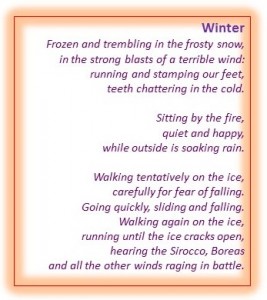
1. “Frozen and Trembling In The Frosty Snow”
Listening composing, performing
- Listen to the 1st Movement of Vivaldi’s Winter. This movement represents the freezing landscape with shivering before an icy wind blows in from the north and sends everything scurrying for cover. How do you think the music represents these wintry ideas?
- We’re going to learn to play the first part of this piece when everything is shivering. Listen to that section again and figure out how Vivaldi represents the shivering.
- The answer is that he asks the violins to play spiky chords, trills and tremolos.
-
- A chord is when a few notes are played at the same time.
- A trill is when two notes are played one after another really quickly. Vivaldi uses really short trills in this piece.
- A tremolo is when the same note is played a few times very quickly.
- Listen again and spot the spiky chords, trills and tremolos.
- Choose an untuned percussion instrument and play some spiky chords (you’ll have to work as a team for this – maybe with a conductor to keep the beat), and some tremolos and trills. A two-handed trill is the hardest as you need to co-ordinate both hands to play together and as fast as possible.
- Play along with the opening of Vivaldi’s music. Keep in time and don’t play too loud.
- It’s hard to play chords on untuned instruments, so now we’ll have a go with the glockenspiels.
- Pick one of these notes and play them in a spiky way. Use your spare hand to damp the note after you’ve played it: F , G, Db or C#, Bb or A#
- 8+ yr olds: Now we’ll play the chords by everyone in the group playing different notes at the same time. Use the musical scores to help get the correct notes. The letter names are written underneath to help you. It might take you a while to practise these patterns. Remember to keep the beat steady.
- 5-7 yr olds: Most pupils will struggle with reading and remembering this many notes at the same time – concentrate on one part only and assign each child to one note only – they play each time that note is pointed at.
- Once you’ve learned one of the parts, the whole group or class should play together with someone conducting to keep time. Did you notice that Part 4 starts on its own, then after 8 notes part 3 joins in, then after another 8 notes, part 2 joins in, and then finally after another 8 notes part 1 joins in, and you should all finish at the same time?
- Now combine some of your untuned trills and tremolos with the spiky chords, and you should be able to play along with the recording in the shivery 1st part of the music.
2.“The Strong Blasts Of A Terrible Wind”
Listening composing, performing
- Vivaldi has three sorts of music in this movement of “Winter” to go with the poem which was published with the scores.
- The first sort of music is the “shivering” music we listened to in the last activity.
- The second sort is the “terrible wind” music where the solo violinist plays lots of fast music with short interruptions of trembling from the rest of the orchestra;
- The third sort is the “stamping and chattering” of teeth music played by the whole orchestra.
- Vivaldi’s “terrible wind” music is way too difficult for us to play, but instead we can make up our own.
- Listen to Vivaldi’s wind music and describe it. Make a list of words and phrases.
- Use these words and phrases to make up your own wind music.
- Do what Vivaldi does and have a solo wind, with interruptions from the trembling music you’ve already learned.
3. “Running, Stamping Of Feet And Chattering Of Teeth”
Listening, composing, moving
- Thinks of words and phrases to do with cold and being cold. Write them on the board. Look in a thesaurus if you would like to make your list longer.
- Say the words to each other in a variety of ways: anxious, happy, miserable, as if you are cold, shocked, surprised, sleepy etc.
- Think of ways we move, gestures we make when we’re cold (for instance rubbing our arms in a hug, blowing onto our hands, rubbing our hands.) Listen to the sounds we make when we do these gestures and moves.
- The poem that goes with Winter mentions three things we do when we’re cold: running, stamping our feet and the chattering of our teeth. Make these sounds too.
- Listen to the music and locate when this cold sounds music happens.
- Accompany the recording with an organised sound collage of your cold sounds, actions and words/phrases.
- Whenever the “terrible wind” and “shivering” music is played you must be silent, but when you hear the “stamping and chattering” music you should perform your cold music.
- You could join all your ideas together now and perform a complete “Winter” of your own. You could keep bringing the “shivering” music back like a Vivaldi ritornello!


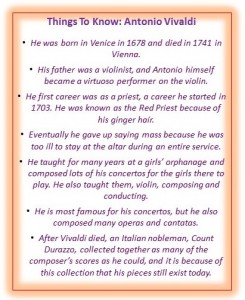
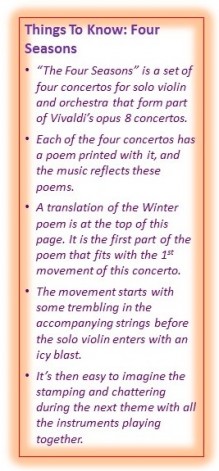

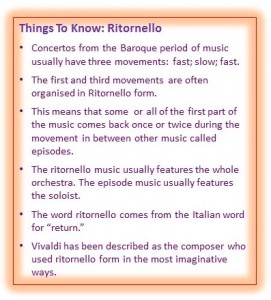
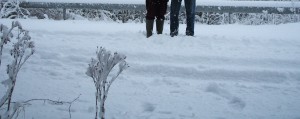
No comments yet.